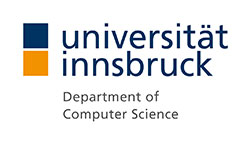We make the measurability of our R&D results one of our primary tasks. We want to show to the world that semantic technologies are becoming reality. Find out more about our results and our spin-off companies.
Europe spins the semantic web
The semantic web, initiated by World Wide Web inventor Tim Berners-Lee, has the potential to rank as one of this decade's most important software developments. A number of exciting new semantic web projects have been recently launched as part of Europe's latest framework research programme. These projects are being showcased in the 1st European Semantic Web Symposium (ESWS 2004) on 10-12 May in Heraklion (www.esws2004.org). The event features a series of tutorials based around these projects, and offers a great opportunity to get up to speed on European and global developments in this area.
Heraklion, Greece (PRWEB) May 12 2004 -- A number of exciting new semantic web projects have been recently launched as part of Europe's latest framework research programme. These projects are being showcased in the 1st European Semantic Web Symposium (ESWS 2004) on 10-12 May in Heraklion (www.esws2004.org). The event features a series of tutorial sessions based around these projects, and offers a great opportunity to get up to speed on European and global developments in this area.
The semantic web, initiated by World Wide Web inventor Tim Berners-Lee, has the potential to rank as one of this decades most important software developments. Through the use of metadata "information about information" the semantic web will help us organise and access the vast amount of material on the web.
It will also open up ways of mapping dependencies and relationships among this material, which will enable computer programs "software agents" to understand it, to process it, and to help us manage it.
While the lower layers of the semantic web, such as XML, are already fairly well defined, much work remains to be done for the upper layers, which are still considerable research challenges.
DIP (Data, Information and Process Integration), one of the research projects featured in ESWS 2004, takes an even more ambitious approach by aiming to further develop and combine semantic web and web service technologies to produce a novel technology infrastructure called semantic web services.
The project is being co-ordinated by the recently created Digital Enterprise Research Institute (DERI). Based in two locations at the National University of Ireland, Galway and at the Leopold-Franzens Universität in Innsbruck, DERI's mission is to make the promise of semantic web real. "Our major objective is to bring current web technology to its full potential by combining and improving recent developments around the web", said Professor Dieter Fensel, the Scientific Director of the Institute.
Furthermore, DIP will contribute substantially to solving one of the most difficult and costly problems of IT, Enterprise Application Integration (EAI). Companies will save a substantial part of the 30% of their IT budget they are forced to spend in this context today.
While significant research still needs to be done, the successful creation of semantic web services could potentially change the way we do business and co-operate electronically, leading to a paradigm shift in our current business practices.
DIP also addresses one of the critical success factors in the market take-up of semantic web services by creating practical solutions to real-world business challenges. These solutions will be showcased in scenarios within single organisations, and between and across multiple organisations operating along the classic business value chain.
DIP believes that a combination of semantic web and web services technology may well deliver the killer application for the semantic web. This combination can provide an infrastructure that will not only revolutionise information processing but also the way we access computational resources in general. It will provide a completely new infrastructure to facilitate more effective and cost-efficient electronic business and enable people to work together in better and more innovative ways.
About the DIP consortium
Project DIP, which started in January 2004, has a budget of around 16.3 million euro over a 3-year period. Up to 10 million euro of the total project cost will be covered by funding from the Information Society Technologies (IST) priority of the EU's Sixth Framework Programme for Research and Technological Development.
The DIP consortium consists of core and associate partners from both the research and business worlds. The core research partners are: The National University of Ireland Galway - Digital Enterprise Research Institute (DERI), the Ecole Polytechnique Fédérale de Lausanne (EPFL) and the University of Innsbruck - Institut für Informatik (IFI). The core industrial partners are British Telecom, ILOG, SAP AG and Tiscali Oesterreich.
Bankinter, the fifth largest bank in Spain, and Essex County Council, a large UK local authority, are case study partners.
Associate research partners and tool developers include FZI Karlsruhe, the Open University, Milton Keynes and the Vrije Universiteit Brussels with Berlecon Research, Inubit, iSOCO, Netdynamics, Sirma AI and Unicorn Solutions.
For more information on DIP, visit http://dip.semanticweb.org/
Contact:
Prof Dr. Christoph Bussler
Digital Enterprise Research Institute (DERI)
Tel +353-91-512460
Fax +353-91-512541
http://dip.semanticweb.org
Contact person in charge.

